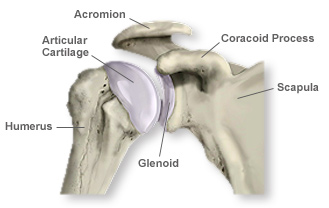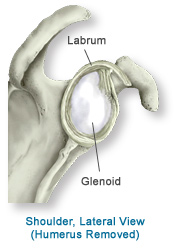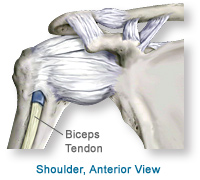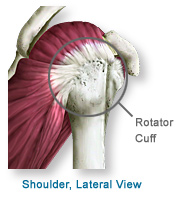Anatomy of the Shoulder
 The two main bones of the shoulder are the humerus and the scapula (shoulder blade).
The two main bones of the shoulder are the humerus and the scapula (shoulder blade).
The joint cavity is cushioned by articular cartilage covering the head of the humerus and face of the glenoid. The scapula extends up and around the shoulder joint at the rear to form a roof, called the acromion, and around the shoulder joint at the front to form the coracoid process.
 The end of the scapula, called the glenoid, meets the head of the humerus to form a glenohumeral cavity that acts as a flexible ball-and-socket joint.
The end of the scapula, called the glenoid, meets the head of the humerus to form a glenohumeral cavity that acts as a flexible ball-and-socket joint.
The joint is stabilized by a ring of fibrous cartilage surrounding the glenoid, called the labrum.
 Ligaments connect the bones of the shoulder, and tendons join the bones to surrounding muscles. The biceps tendon attaches the biceps muscle to the shoulder and helps to stabilize
Ligaments connect the bones of the shoulder, and tendons join the bones to surrounding muscles. The biceps tendon attaches the biceps muscle to the shoulder and helps to stabilize
the joint.
 Four short muscles originate on the scapula and pass around the shoulder where their tendons fuse together to form the rotator cuff.
Four short muscles originate on the scapula and pass around the shoulder where their tendons fuse together to form the rotator cuff.
All of these components of the shoulder, along with the muscles of the upper body, work together to manage the stress the shoulder receives as you extend, flex, lift, and throw.

